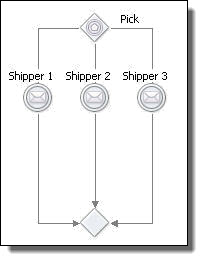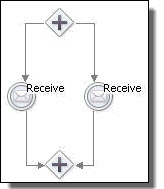Informatica ActiveVOS
- Informatica ActiveVOS 9.2.5
- All Products

Required Properties
| Optional Properties
|
|---|---|
Participant (Partner Link)
| Name. See
Selecting Activity Labels
|
Operation
| Port Type
|
Variable (required only for executable process, not abstract process)
or
From Part to Variable. See
From Part to Variable .
| Correlations. See
Correlation
|
Create Instance. Required if this is the start activity.
| |
Join Condition. See
Creating a Join Condition for an Incoming Link
| |
Suppress Join Failure. See
Process Properties
| |
Comment. See
Adding Comments to a Process
| |
Documentation. See
Adding Documentation to a Process
| |
Execution State.
Viewing the Execution State of an Activity or Link
| |
Message Exchange.
Message Exchange Declaration
| |
Extension Attributes and Extension Elements. See
Declaring Extension Elements and Attributes .
|
One receive can start a process

| In a pick (event-driven gateway) with onMessage activities, one of many can start a process; the rest are ignored

| Any one starts a process; all are required to complete the fork join (flow )

|
<receive partnerLink="NCName" portType="QName"? operation="NCName" variable="BPELVariableName"? createInstance="yes|no"? messageExchange="NCName"? standard-attributes> standard-elements <correlations>? <correlation set="NCName" initiate="yes|join|no"?>+ </correlations> <fromParts>? <fromPart part="NCName" toVariable="BPELVariableName"/>+ </fromParts> </receive>
<receive name="ReceiveCustomerRequest" partnerLink="customer" portType="lns:loanServicePT" operation="request" variable="request" createInstance="yes"/>